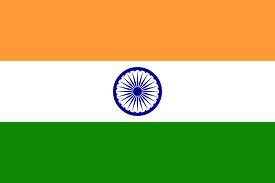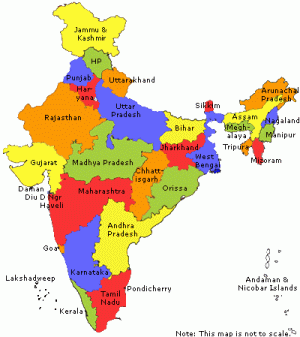
Flag of Republic of Bharat (India)
|
Many writers have described India as not a country but a continent. India is a huge land mass, that has a range of different climates and people, ranging from extreme cold – Himalayan mountain range to arid deserts of Rajeshthan.
There’s not enough space write everything about India but here are some basic information that you may find useful.
| Official Name | Bharat (Republic of India) |
| Capital | |
| Flag | The colors of the Indian flag were taken from the flag of the Indian National Congress. Dark orange represents courage and sacrifice. Green represents faith, fertility, and chivalry. White represents truth and peace. The emblem in the middle is the Ashok chakra created by Ashoka the Great. |
| Anthem | “Jana gana mana” (“Thou Art the Ruler) |
| Currency |
Indian Rupee |
| Government | Federal Republic Head of State President Elected by an electoral college to a five-year term Head of Government Prime minister Appointed by the president Legislature Bicameral legislature Lok Sabha (House of the People) 545 members Rajya Sabha (Council of States) 245 members Voting Qualifications Universal suffrage for all citizens age 18 and older Highest Court Supreme Court. |

Map of India
|
| Area | 3,165,596 sq km (1,222,243 sq mi) |
| Highest Point | Kanchenjunga 8598 m (28,209 ft) above sea level |
| Lowest Point | Sea level along the coast |
| Delhi | Mumbai | |
| Average Temperatures |
January 14° July 32° C |
January 24° C July 27° C |
| Average Annual Precipitation | 640 mm (25 in) | 1810 mm (71 in) |
| Population | 1.25 Billion |
| Largest Cities | Mumbai9,925,891 – Delhi 7,206,704 – Calcutta4,399,819 (1991 census) |
| Official Languages | Hindi, English |
| Other Languages | Assamese, Bengali, Gujarati, Kannada, Kashmiri, Konkani, Malayalam, Manipuri, Marathi, Nepali, Oriya, Punjabi, Sanskrit, Sindhi, Tamil, Telugu, Urdu; many other languages and dialects |
Religions
| Hinduism | 78.4% |
| Islam | 14.6% |
| Sikhism | 4% |
| Christianity | 2% |
| Buddhism and Jainism | 1% |
Economy
| Gross Domestic Product (GDP) | $1.85 trillion |
| Chief Economic Products | Agriculture Sugarcane, rice, wheat, tea, cotton, jute, vegetables, melons, sorghum, millet, cashews, coffee, spices, livestock Fishing Shrimps and prawns, croakers, Indian oil sardines, Bombay ducks, anchovies, Indian mackerel, marine catfish Mining Iron ore, coal, bauxite, manganese, mica, dolomite, copper, petroleum, natural gas, chromium, lead, limestone, phosphate rock, zinc, gold, silver Manufacturing Textiles, iron and steel, processed agricultural products, machinery, transportation equipment, nonferrous metals, fertilizer, refined petroleum, chemicals, computer software |
64%Agriculture, Forestry, and Fishing 20%Services 16%Industry Major Exports
Gems and jewelry, engineering goods, garments, chemicals and pharmaceuticals, cotton yarn and fabrics, leather and leather goods, marine products, iron ore, tea, vegetables and fruit, petroleum products, handmade carpets.
Petroleum and petroleum products, nonelectric machinery, precious and semiprecious stones, inorganic chemicals, iron and steel, fertilizers, electrical machinery, resins and plastics.
Russia, Israel, China, USA, Iran, UK, Singapore.
The Indian Armed Forces have kept close relations with Russia and Israel buying the majority of weapons from these two countries. The relations with USA continue to warm as both countries fight against terror.
India is a part of the UN and the Non-Aligned Movement.
1,325,000 Total Armed Forces
2,142,821 Total Reservists
Major Universities and Colleges
University of Bombay
University of Calcutta
University of Madras, Chennai
University of Delhi
